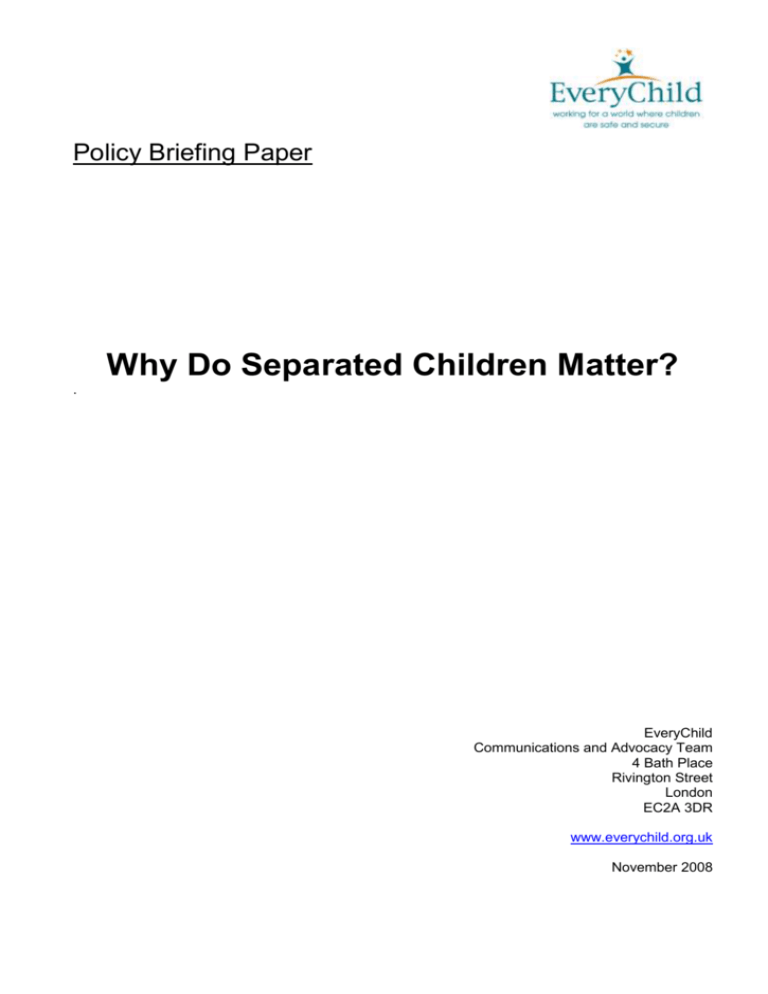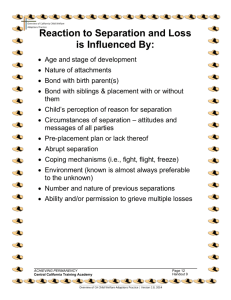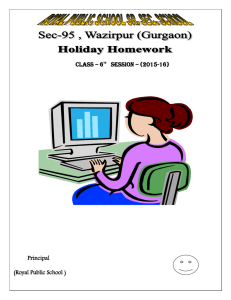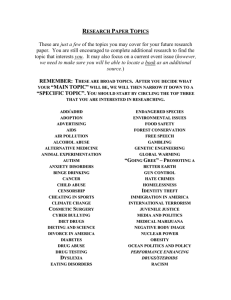
Policy Briefing Paper
Why Do Separated Children Matter?
.
EveryChild
Communications and Advocacy Team
4 Bath Place
Rivington Street
London
EC2A 3DR
www.everychild.org.uk
November 2008
Policy Briefing Paper
Why Do Separated Children Matter?
Introduction
EveryChild is an international development charity working in over 15 countries around the world.
EveryChild’s focus is children separated from their families and communities or in danger of being so.
We do this through three different intervention types: Prevention, Protection and Re-integration. This
clear focus on separation sets EveryChild apart from other INGOs
EveryChild believes the separation of children from their families or usual carers in developing
countries is seriously undermining attempts to build healthy communities and meet development
goals. Articles 7,8 and 9 of the United Nations Convention on the Rights of the Child state that
children have the right to be cared for by their parents, that governments must respect family ties and
children should only be separated from their families if it is in the best interests of the child.
However, there is very little policy and research around separation as a global issue with most NGOs
and governments preferring to focus on analysis of specific groups of vulnerable children such as
street children or child labourers. EveryChild believes that the additional damage of separation is
hidden within these groupings. A lack of understanding of the specific situations and needs of highly
marginalised separated children means that many interventions may fail to target their specific needs.
It is essential that research is undertaken that looks at separation as a specific issue to ensure that
interventions reach the most vulnerable children within these and other groupings. EveryChild hopes
this paper and the research planned to follow will enrich our understanding of separation as a global
development issue and enable us to advocate more effectively on behalf of children separated or at
risk of being so.1
1 Who are these separated children?
Separated children are boys and girls who have been separated from their parents, carers or families
over a period of time. There are many push factors that can result in separation, including poverty,
violence and abuse in the home, the death of parents, armed conflict or natural disasters. Separated
children are not a homogenous group. Separation comes in many different forms. The challenge for
organisations working with vulnerable children is delivering interventions informed by research that
indicates the specific nature of separation in different contexts.
Separated children can be categorised according to the push factors that may have caused their
separation. For example:
Children who have been orphaned, especially those orphaned by HIV and AIDS
Children who have become separated for the purposes of exploitation e.g. trafficked children
Child refugees who have become separated from family by armed conflict
Children with a disability placed in institutional care
Separated children can also be categorised according to their living situation. For example:
Children living in institutions
Children held in detention
Child-headed households
Children living on the streets
Children living with employers (e.g. child domestic workers)
1
This paper is based on a desk review and interviews with EveryChild staff. More comprehensive research is planned for
2009.
2
2 Why does a child’s separation matter?
2.1 Separation threatens children’s survival and development
Separated girls and boys are at risk of a range of problems which affect their survival and
development. Very young children are especially vulnerable, with 0-3 years old facing increased risk
of mortality if they lose their mothers (UNICEF et al 2006). The sexual abuse and early sexual activity
associated with some forms of separation, such as early marriage or trafficking into prostitution,
exposes children to sexually transmitted infections (STIs), and girls to the risks associated with early
pregnancy (Pinheiro 2006). Children living on the streets, and children who have been in conflict with
the law have been noted to engage in risky activities which expose them to HIV infection (Pinheiro
2006; Ban Ki-Moon 2007). Orphans are also more at risk of STIs than non-Orphans (UNICEF et al
2006).
As shown below, violence, abuse and neglect suffered by separated children can threaten physical
health and chances of survival. The abuse, neglect, exploitation and loss often associated with
separation can also cause children major mental health problems. Research in Uganda suggests
high levels of anxiety and depression amongst orphans with 12% stating that they sometimes wished
they were dead (UNICEF et al 2006). In Russia, it has been reported that a staggering 1 in 10 young
people leaving in institutions commit suicide ( cited in Pinheiro 2006).
Boys and girls who live apart from their parents are more vulnerable to malnutrition. Children who
have been orphaned by AIDS often either struggle to provide for themselves in child headed
households (see Walker 2002), or live in large extended families where adults, frequently elderly
grandparents, are unable to provide for all the children in their care (UNICEF et al 2006). The
vulnerability of orphaned children is compounded by discrimination, with many children, living without
their parents, receiving different food and clothing from other children in the household (UNICEF et al
2006). Children who live with employers, such as child domestic workers or trafficked children, are
often given inadequate food, and may even be denied food as a form of punishment (Blaghbrough
2008).
There is widespread evidence that children who are denied a loving, continuous bond with a parental
figure suffer major developmental set backs. Children in institutional care in Central and Eastern
Europe and the Former Soviet Union have been shown to suffer from low IQ, poor motor skills, and
delayed language development (EveryChild 2005; Johnson et al. 2006; Tolfree 2003).
2.2 Separation threatens children’s education
Evidence suggests that the majority of separated children are unable to receive an adequate
education. For example, in Uganda 27% of children who have lost both parents stopped primary
school at some point, compared with 14% of children who are not orphans (UNICEF et al. 2006). As
with the allocation of food, orphans may be discriminated against in decisions about education within
the household. Research in ten Sub-Saharan African countries found than orphans were less likely to
receive an education than other children in the same household (cited in UNICEF et al. 2006).
Children who are separated for the purposes of exploitation may be especially unlikely to receive an
adequate education as their work often prevents them from regularly attending school. Although child
domestic workers are often supposed to receive an education in return for their work, evidence
suggests that in reality the employers that they live with often deny them this right (Blaghbrough
2008). For girls, leaving their parental home to go to live with husbands following early marriage
usually puts an end to all hope of attending school (Pinheiro 2006).
2.3 Separation exposes children to exploitation, violence and abuse
The recent UN global report on violence against children listed children particularly vulnerable to
violence and abuse. A striking proportion of these girls and boys are separated children including
children living in institutions, children in detention, children living on the streets, orphaned children,
trafficked children and children who have been forced into early marriage (Pinheiro 2006). The report
shows that separation exposes children to often extreme forms of violence in a number of different
settings:
3
In institutions: The high levels of physical, mental and sexual abuse experienced by children in
institutions have been widely documented (EveryChild 2005; Pinheiro 2006; Tolfree 2003). For
example, in Kazakhstan, 63% of children in state run children’s homes have reported violence. In
Romania, one third of institutionalised children are aware of cases where children are obliged to
have sex with staff or older children (Pinheiro 2006). Shockingly, abuse can be legally
sanctioned, or used as a form of treatment. In 145 states, corporal punishment and other forms of
degrading punishment are not explicitly prohibited in institutions. In Turkey, ECT is still used on
children in psychiatric institutions (Pinheiro 2006).
In detention: In 78 countries, corporal punishment remains a legal disciplinary measure against
children in detention. In 31 states, corporal punishment is still permitted as a sentence against
children. In many countries, violence is used to extract confessions from children. Children may
be placed in detention with older children or with adults, further exposing them to risks of violence
and abuse (Pinheiro 2006).
In the home: Orphans living with extended family members are often treated differently from
other children in the household. This discrimination can extend to violence and abuse. Research
suggests that corporal punishment is more common against orphans than other children in the
household. A study in Zambia shows that orphans taken in by extended family members are
often subject to sexual abuse from uncles, step fathers and cousins (Pinheiro 2006). Child
domestic workers living in the homes of their employers are often subject to verbal, physical and
sexual violence. This abuse may come from employers and from other children in the household
(Blagbrough 2008). Girls who are forced to marry early may be subject to rape and domestic
violence from their often older husbands. In-laws may also punish girls for inadequate dowry
payments or not fulfilling their ‘duties’ as a wife or mother (Pinheiro 2006).
On the streets: Children living and working on the streets are often viewed as a nuisance. This
can lead to violence on the part of police, security guards and members of the public (Delap
2008). In extreme cases, vigilante groups have been formed to rid the streets of beggars, leading
to reported murders of street children (Pinheiro 2006).
Separated children are often exploited through harmful forms of work. This exploitation may be the
driving force behind their separation, as with child domestic work. Separation for other reasons, such
as due to conflict or natural disasters, may place children at greater risk of exploitation. For example,
research on child soldiers in three West African countries shows that children are more likely to likely
to be recruited if they do not have the protection of parents or carers (Delap 2005).
2.4 Separated children experience high levels of stigma and discrimination
Children’s separation is often associated with stigma and discrimination. Children who have been
orphaned by AIDS suffer discrimination as they are not the biological children of their carers (UNICEF
et al 2006). Those born to HIV + mothers face stigma as a result of either their own or their parent’s
HIV status, and children in institutions may feel rejected by their families and discriminated against by
the wider society because they live in children’s homes (Tolfree 2003). As shown above , children
often suffer from sexual abuse as a result of their separation. For girls, early pregnancy can lead to
rejection by families and communities (Blaghbrough 2008; EveryChild 2005). Children may face
discrimination because of the work they are forced to do as a result of their separation. This is
particularly the case with child beggars, child soldiers and child commercial sex workers (Delap 2005;
Delap 2008).
2.5 Separated children are becoming more vulnerable
Rising food prices mean that poor communities need more support to survive and the World Food
Programme are currently calling for an extra $500 million in food aid. However, developed countries’
foreign aid expenditure declined for the second consecutive year in 2007 (UN 2008), and many
countries are hinting at cutting aid further (Evans 2008). Such reductions are likely to hit vulnerable
groups such as separated children hardest. In South Africa, news reports already show that feeding
programmes for orphans have had to reduce the amount and quality of food provided because the
cost of food has increased so much.
4
3 Children’s separation: A substantial and growing problem
In part because of a lack of attention paid to separated children, no one really knows how many
separated boys and girls there are in the world today. However, some estimates of the more common
and widely recognised forms of separation highlight the enormity of the problem:
In Sub-Saharan Africa in 2005, 12% of the child population were orphans; that is 48.3 million
children, including 9.1 million ‘double orphans’ who have lost both parents (UNICEF et al
2006). Although many of these children are taken in by extended families, evidence suggests that
orphans often lack proper parental care as they face discrimination and abuse in their new homes
(Pinheiro 2006).
There are an estimated 8 million children in institutionalised care across the world (Pinheiro
2006).
Many believe that global estimates of 1 million children in detention (UNICEF 2007)
underestimate the extent of this problem. In the US alone, 600,000 teen-ages spend time in
detention every year (Pinheiro 2006).
Around 1.2 million children are trafficked each year (ILO 2006)
Millions of girls work as child domestic workers, often living apart from their families. In Dhaka,
Bangladesh alone there are around 300,000 child domestic workers (ILO-IPEC 2007).
Around 10% of the estimated 100-150 million street children across the world have made the
streets the home (Consortium for Street Children 2006; UN Violence Study).
82 million girls now aged between 10-17 years will marry before 18, with many going to live
with their husbands family (Pinheiro 2006)
More than half a million children (at least one fifth of the child population) were deprived of
parental care as a result of the Rwanda genocide. Up to 1,500 children who survived the
earthquake in Bam, Iran in 2003 lost their parents (UNICEF and International Social Services
2004). After the tsunami, Save the Children registered over 7000 separated children (Save the
Children UK website).
These estimates suggests that there are millions of separated boys and girls in both industrialised and
developing countries. Alarmingly a number of current global trends suggest that the already vast
number of separated children is likely to grow in the coming years.
3.1 Slow progress towards Millennium Development Goals will lead to more separated children
Reports at the mid-way point for achieving the Millennium Development Goals (MDGs) highlight much
important progress, but also many areas of concern. Slow progress towards some of the key targets
will increase the number of separated children globally. For example:
The proportion of people in sub-Saharan African living on less than $1 per day is unlikely to be
reduced by the target of one half by 2015 (UN 2008). In Africa, as elsewhere in the world, poverty
is major factor behind children’s separation. For example, poverty interacts with abuse, neglect
and violence in the home to push children away from their families and into institutional care
(EveryChild 2005; Meintjes et al 2007 and Tolfree 2003). Girls and boys are often trafficked, or
sent to work as domestic workers because families don’t have enough to feed them (Blagbrough
2008; Dottridge 2004).
Several indicators suggest that targets on gender parity are not being met across the world (UN
2008). Separation often stems from unequal power relations in and outside the home. For
example, beliefs about appropriate roles for girls and their powerlessness within the family leave
many vulnerable to early marriage and domestic service.
More than 500,000 prospective mothers die annually in childbirth or through complications in
pregnancy each year, leaving many children without their mothers (UN 2008). Evidence suggests
that children who have lost their mothers are even more vulnerable than those who have lost their
fathers (UNICEF et al 2006).
5
Carbon dioxide emissions have continued to increase (UN 2008). Global warming will enhance
children’s vulnerability to separation in a number of ways. For example, increases in diseases
and malnutrition due to rising temperatures and water and food shortages will increase parental
morbidity and mortality. Rising poverty and the need to develop new survival strategies will push
children out of school and into work. The chaos and loss of life created by natural disasters will
lead to many children loosing contact with their families. After the Asian tsunami, WHO
expressed concern at an increase in child trafficking in the region since so many children had lost
their mothers (UNICEF 2008).
Even where progress is now being made towards achieving the MDGs, evidence shows that past
slow progress will leave a lasting legacy for children. Reports show a significant fall in HIV and AIDS
infection and death rates (UN 2008). However, the delay between infection and death means that the
number of orphans is still set to rise to 53.1 million by 2010 (UNICEF et al 2006). Many are
concerned that communities will not be able to cope with the care of growing numbers of orphans,
leading to increasing institutionalisation (Pinheiro 2006; UNICEF et al 2006).
3.2 Rising commodity prices and global recession makes children more vulnerable to
separation
The combination of rising commodity prices and global recession is having a devastating impact on
the world’s poor (Evans 2008; Save the Children 2008; Ravillion 2008). The World Bank estimates
that world food prices have gone up by 83% in the last 3 years (cited in Evans 2008). To place these
figures in context, in one region of Ethiopia it took 60% of family income to buy the 25% of annual
food needs not covered by the annual harvest in 2001. By April 2008, the same proportion of income
only covered 7% of food needs (Save the Children 2008). As shown above, sending children away to
work or to institutions is a survival strategy used by many poor families in times of need. A worsening
economic situation can also lead to adult ill-health and death and children’s removal from school
(Save the Children 2008), both of which leave children more vulnerable to separation from their
families. For example, it has been shown that education reduces children’s vulnerability to trafficking
by giving them an alternative to exploitative forms of work and the skills and confidence to negotiate
with would-be traffickers (Dotteridge 2004).
3.3 Inadequate protection against violence, abuse and neglect will increase the number of
separated children
Two major global reports have pointed towards a continued failure to adequately protect children from
violence, abuse and neglect (Ban Ki-Moon 2007; Pinheiro 2006). The UN study on violence against
children highlights the pervasive nature of violence in children’s lives, affecting girls and boys in
developing and industrialised nations, and in all areas of their lives, including homes, schools, and
workplaces (Pinheiro 2006). A recent review of progress against the MDGs and goals made at the
UN Special Session for Children in 2002 shows serious failings in efforts to protect children against
abuse, exploitation and violence (Ban Ki-Moon 2007). EveryChild’s own experience has shown that
such failings are a major reason behind children’s separation. Research suggests that violence or
abuse within the home is often a driving force behind children’s entry into institutions. For example, in
South Africa many staff in children’s homes report that being an orphan in itself is usually not enough
to push children into residential care. In most cases, children have also experienced violence abuse,
or neglect at the hands of their carers (Meintjes et al 2007). This is reflected by research elsewhere
in the world (Pinheiro 2006). In Peru, violence and child mistreatment are precipitating factors in 73%
of cases of children migrating to the streets (Pinheiro 2006).
The impact of violence, abuse and neglect on children’s separation is compounded by inadequate or
inappropriate child protection policies in many countries. Particularly common failings likely to lead to
an increase in children’s separation include:
A continued reliance on institutional care: Despite widespread global recognition of the risks
associated with residential care, many countries continue to rely on children’s homes for the care
and protection of children. In Central and Eastern Europe and the former Soviet Union, where
such care has traditionally been most widely used, evidence suggests that far from falling in the
post-communism era, there was an initial rise in the proportion of children in institutions
6
(EveryChild 2005). In Africa, there is growing concern about the burgeoning number of
orphanages being established by often well meaning private donors and faith-based organisations
to meet the perceived needs of children affected by HIV and AIDS (Pinheiro 2006).
The widespread use of child detention: Child detention is still widely used in most parts of the
world, with often limited efforts made to find alternatives ways of addressing youth crime. In some
countries, public concern about delinquency has increased pressure on governments to widen the
use of detention. For example, in England and Wales, the number of children sentenced to penal
custody increased by 90% between 1994 and 2004 (Pinheiro 2006).
4 Children’s separation has wider implications for the ability to meet
development goals
Aside from having a devastating impact on children’s lives, the evidence presented above suggests
that separation also has wider ramifications for efforts to achieve the MDGs. The Box below
summarises the effect of separation on reaching the MDGs, and the impact of progress in achieving
the MDGs on the numbers of separated children.
The relationship between the MDGs and children’s separation from their parents and carers
MDG
The impact of separation on the MDGs
The impact of the MDGs on separation
Eradicate extreme
poverty and hunger
Separated children are more
vulnerable to malnutrition
Damage to education and child
development caused by separation
may lead to poverty in adult-hood
Poverty is a major driving force
behind children’s separation
Achieve universal
primary education
Separation prevents children from
attending school
Education reduces children’s
vulnerability to many forms of
separation e.g. trafficking
Promote gender equity
and empower women
Separation can perpetuate gender
inequity by, for example, denying
girls a right to an education
The powerlessness of girls leaves
them vulnerable separation through
early marriage, domestic work or
trafficking.
Reduce child mortality
Young children are more likely to die
if they don’t live with their mothers
Improve maternal
health
Separated children are often
exposed to early sexual activity and
consequent early pregnancy with
associated higher risks to maternal
health.
High rates of death during pregnancy
and child birth deny many children a
mother.
Combat HIV/AIDS,
malaria and other
diseases
Many separated boys and girls,
including trafficked children, children
living on the streets, and orphaned
children, are at higher risk of HIV
infection.
HIV/AIDS, and other diseases have
left many girls and boys without one
or both of their parents.
Ensure environmental
sustainability
A future increase in natural disasters
as a result of global warming will lead
to more separated children in the
future.
Develop a global
partnership for
development
Reduced aid flows increases the
vulnerability of separated children
7
5. Initial policy recommendations
The findings presented in this paper suggest that any development agency concerned with child
rights or meeting the Millennium Development Goals must consider children’s separation in their
work. EveryChild’s extensive experience of working with separated children suggests that work to
address children’s separation must take place in three areas.
Prevent children’s separation
Target children vulnerable to separation through poverty reduction strategies and education
sector plans.
Work with governments to reduce the number of children in detention and institutional care.
Include strategies to prevent child separation in emergency or response plans.
Support families and work to reduce violence, abuse and neglect in the home.
Protect separated children:
Ensure that separated children are able to access quality education and health services,
including sexual and reproductive health.
Target food aid to separated children.
Develop advocacy programmes to reduce the stigma and discrimination faced by many
separated children.
Work to protect separated children from violence and abuse in institutions, homes,
workplaces, and on the streets.
Re-integrate separated children with their families and communities:
Work with governments to remove children from institutions, either through supporting families
to care for these children, or, where this is not possible, through alternative family based care.
Encourage communities to accept and support formerly separated children.
To support these efforts, EveryChild calls on the UK’s Department for International
Development to devote some of its substantial support to development research towards
major analysis of the extent, causes and consequences of children’s separation.
EveryChild
November 2008
8
References
Ban Ki-Moon (2007) Children and the Millennium Development Goals. Progress Towards a World Fit
for Children UNICEF, New York
Blaghbrough, J (2008) ‘They Respect their Animals More’ Voices of Child Domestic Workers AntiSlavery International, London
Consortium for Street Children (2006) Who we are and what we do Consortium for Street Children
Website:
Delap, E (2005) Fighting Back. Child and Community Led Strategies to Avoid Children’s Recruitment
into the Armed Forces and Groups in West Africa Save the Children UK, London
Delap, E (2008) Begging for Change. Research Findings and Policy Recommendations on Child
Begging and Forced Child Begging in Africa, Asia and Europe Anti-Slavery International (publication
pending)
Dottridge, M (2004) Kids as Commoditions. Child Trafficking and What to do About it Terre des
home, Geneva
Evans, A (2008) Rising Food Prices. Drivers and Implications for Development Chatham House
Briefing Paper, London
EveryChild (2005) Family Matters. A Study of Institutional Child Care in Central and Eastern Europe
and the Former Soviet Union EveryChild, London
ILO (2006) The End of Child Labour: Within Reach ILO, Geneva
ILO/ IPEC (2007) Hazardous Child Domestic Work. A Briefing Sheet ILO/ IPEC Geneva
Johnson, R, Browne, K, Hamilton-Giachritsis, A (2006) ‘Young Children in Institutional Care at Risk of
Harm’ in Trauma, Violence and Abuse Vol. 7, No.1 January 2006
Meintjes, M, Berry, L and Mampane, R (2007) Home Truths. The Phenomenon of Residential Care
for Children in a Time of HIV/AIDS Children’s Institute, University of Cape Town and Centre for the
Study of AIDS, University of Pretoria
Pinheiro, P (2006) World Report on Violence Against Children United Nations, New York
Ravillion, M (2008) Bailing out the World’s Poorest. Policy Research Paper 4763 World Bank,
Washington
Save the Children UK (2008) Rising Food Prices. Implications for Children and Recommendations
Save the Children UK, London
Tolfree, D (2003) Community Based Care for Separated Children Save the Children Sweden, Sweden
UN (2008) The Millennium Development Goals Report 2008 United Nations, New York
Unicef (2008) Our climate, Our Children, Our Responsibility. The implications of Climate Change for
the World’s Children UNICEF, London
UNICEF, UNAIDS and US Presidential Emergency Plan for AIDS Relief (2006) Africa’s Orphaned and
Vulnerable Generations – Children Affected by AIDS UNICEF, New York
UNICEF and International Social Services (2004) Improving protection for children without parental
care. Care for children in emergency situations: implications for international standards Unicef and
International Social Services New York/ Geneva
Wlaker, L (2002) “ We will bury ourselves” A Study of Child-Headed Households on Commercial
Farms in Zimbabwe Farm Orphan Support Trust of Zimbabwe
9








